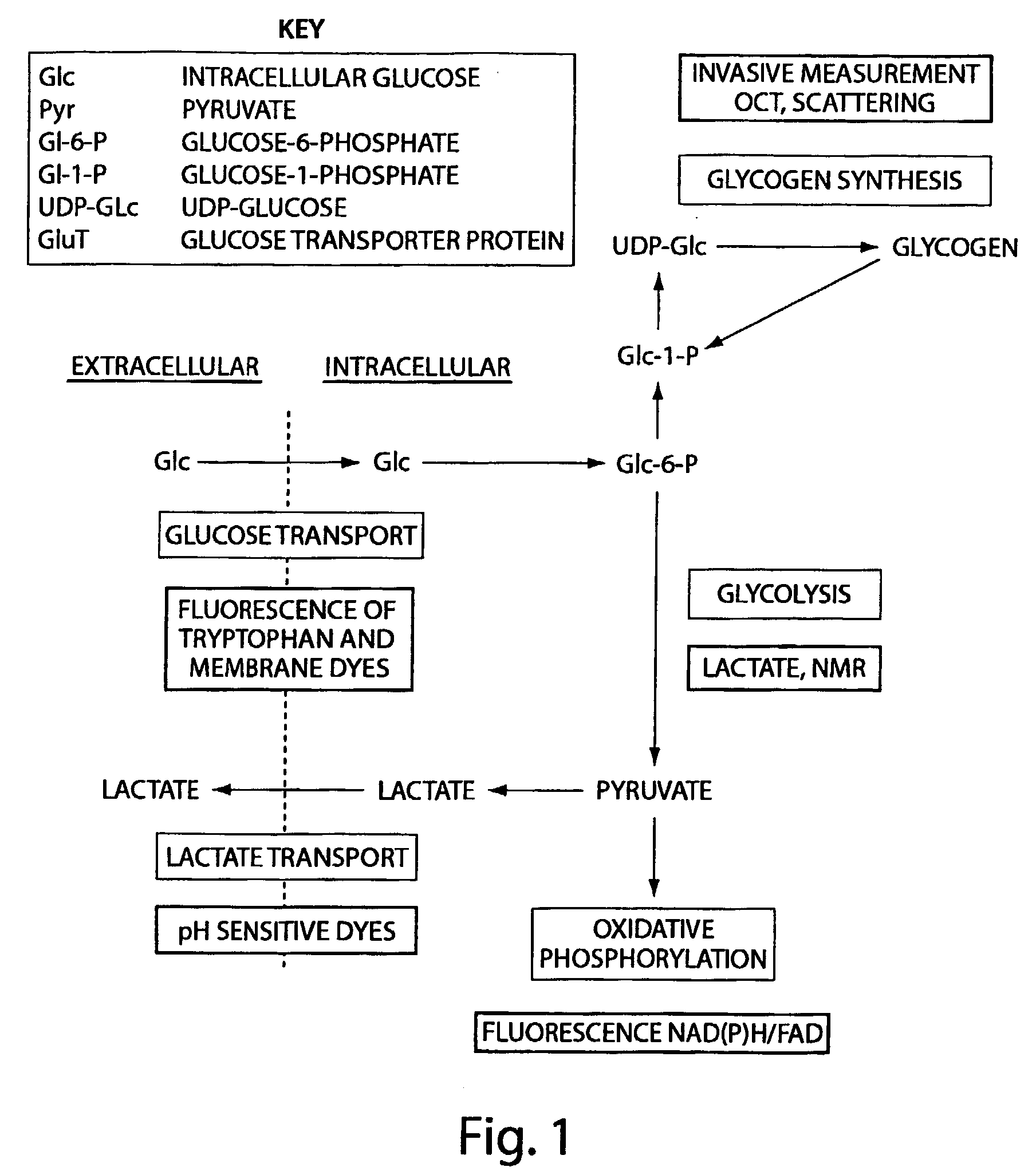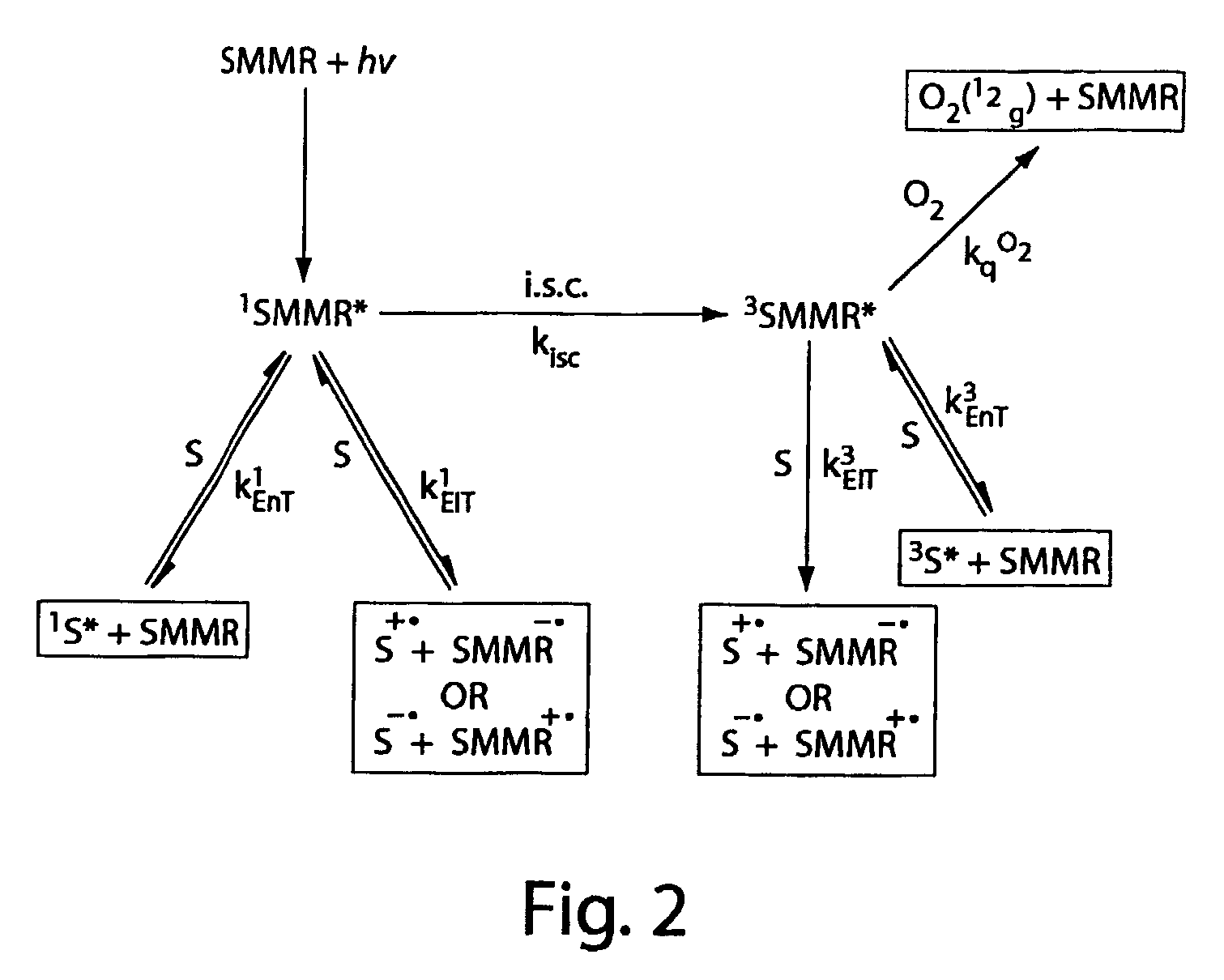Smmr (Small Molecule Metabolite Reporters) For Use As In Vivo Glucose Biosensors
a small molecule metabolite reporter and in vivo technology, applied in the field of small molecule metabolite reporters for use as in vivo glucose biosensors, can solve the problem that the analytical probe imposes some severe limitations on any measurement techniqu
- Summary
- Abstract
- Description
- Claims
- Application Information
AI Technical Summary
Benefits of technology
Problems solved by technology
Method used
Image
Examples
example 1
Using pH to Track D-Glucose Concentration in Living Cells
[0259]For human keratinocytes, the carefully measured intracellular pH (as a measure of lactate production) is directly proportional to the concentration of D-glucose entering the cell. Thus, a decrease of intracellular pH is indicative of an increase in glucose concentration. The lactate formation within the cell is in direct proportion to the quantity of glycolysis occurring within the cell, and this glycolysis is ‘fueled’ by D-glucose and other simple sugars, such as fructose and galactose. This example demonstrates the protocol for precise pH measurement within viable cells, which is directly related to the D-glucose concentration within viable human keratinocytes.
[0260]A-431 cells obtained from ATCC (#CRL-1555) are seeded at 5×105 cells in 35 mm culture dishes (Falcon #353801) containing a #2 25 mm cover glass (VWR#48382-085). Cells are incubated in 2 mL Dulbecco's Modified Eagle's Medium at 100 mg / dL D-glucose (Gibco #11...
example 2
Using External, In Vivo pH Measurement to Track Blood Glucose or Blood Lactate
[0269]The rationale for measuring blood glucose levels or blood lactate levels using external, in vivo optical measurements of SMMR activity within skin is demonstrated. Fluorescence measurements in vivo of SMMR placed within the skin during glucose clamp studies were designed to improve the observation of the correlation between glucose levels and measured pH changes.
[0270]After improvements of fluorescence measurements, additional clamp studies with better control over anesthesia were done to demonstrate the consistency and reliability for the correlation between glucose levels in blood and the reporter dye fluorescence ratio.
[0271]This description demonstrates the results of additional glucose clamp studies during which fluorescence signals were measured in vivo after dye injections using low-cost components comprising a fluorescence sensing device.
[0272]An example ratiometric pH reporting dye was prepa...
example 3
Using NADH Fluorescence to Track D-Glucose Concentration in Living Cells
[0296]A set of demonstration experiments for living cells has shown the expected trend in NADH signals with respect to a change in glucose concentration, as shown in FIG. 12 (glucose from 0 to 400 mg / dL) and FIG. 13 (glucose from 0 to 66 mg / dL). All glucose concentrations above ˜5 mg / dL were well above the saturation limit as can be seen by the lack of any further change in signals.
[0297]A second set of demonstration experiments was designed to determine the saturation limit by varying glucose concentration from 0 to 5 mg / dL and back to zero. The saturation point is expected to have a value between 0.0 and 2 mg / dL.) As shown in FIG. 14 an approximate linear increase in NADH fluorescence is observed with glucose concentration from 0 to 5 mg / dL (0.28 mM). FIG. 15 is a plot of a background subtracted NADH signal where the background changed linearly as determined from the first zero glucose signal and the last (nea...
PUM
| Property | Measurement | Unit |
|---|---|---|
| concentration | aaaaa | aaaaa |
| concentration | aaaaa | aaaaa |
| concentration | aaaaa | aaaaa |
Abstract
Description
Claims
Application Information
 Login to View More
Login to View More - R&D
- Intellectual Property
- Life Sciences
- Materials
- Tech Scout
- Unparalleled Data Quality
- Higher Quality Content
- 60% Fewer Hallucinations
Browse by: Latest US Patents, China's latest patents, Technical Efficacy Thesaurus, Application Domain, Technology Topic, Popular Technical Reports.
© 2025 PatSnap. All rights reserved.Legal|Privacy policy|Modern Slavery Act Transparency Statement|Sitemap|About US| Contact US: help@patsnap.com



